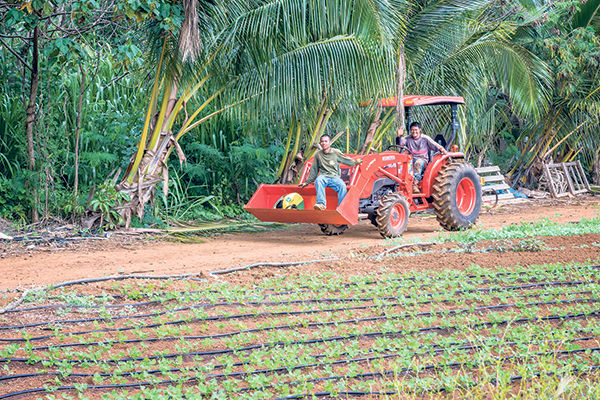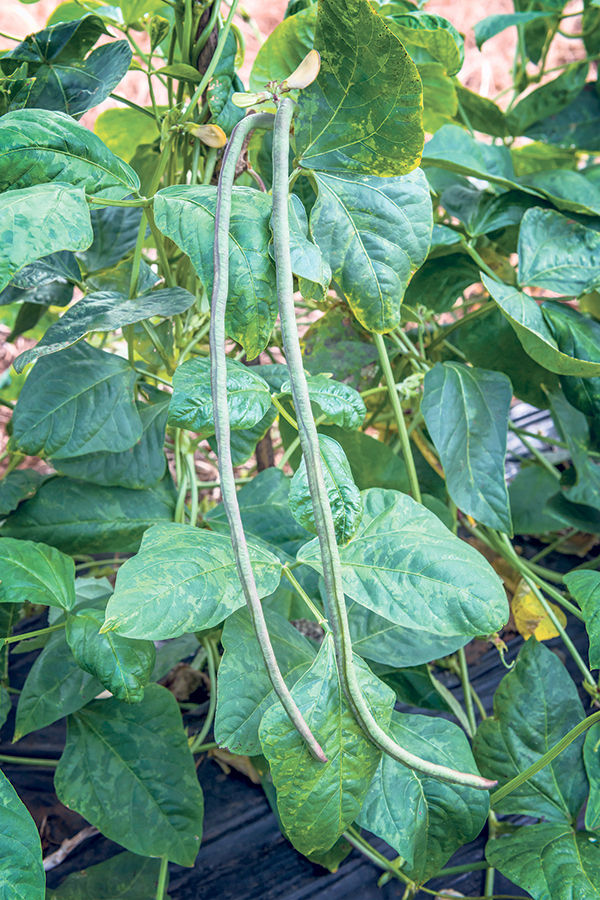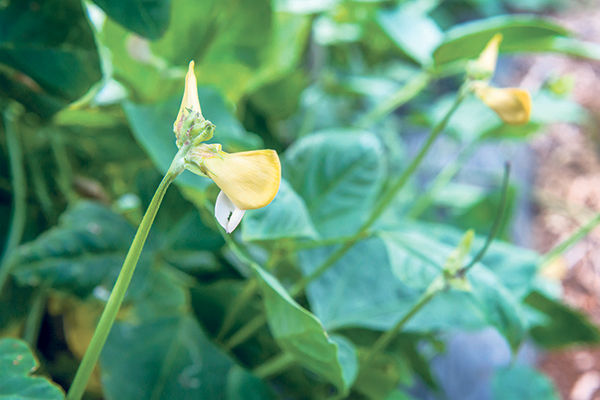Elmer’s Farm is owned and operated by Elmer and Ailyn (pronounced Eileen) Viernes. The couple grows fruit and vegetables on 15 acres at Kilohana Plantation and on 25 acres at Grove Farm. Sustainable farming techniques include seed saving, crop diversity,
Elmer’s Farm is owned and operated by Elmer and Ailyn (pronounced Eileen) Viernes. The couple grows fruit and vegetables on 15 acres at Kilohana Plantation and on 25 acres at Grove Farm. Sustainable farming techniques include seed saving, crop diversity, crop rotation, chicken manure as fertilizer, and no chemical pesticides.
What’s growing
Apple banana, beets, bitter melon, bok choy, cherry tomato, chicken eggs, eggplant, herbs, Chinese ginger, green onion, jícama, long beans, okra, peanuts, pineapple, pumpkin, non-GMO sunrise papaya, sweet potato, wing beans and turmeric.
Long beans
Long beans are edible at all stages of growth. Tender green leaves are an important food source in Africa and are prepared like spinach. Immature pods are used in the same way as snap beans. Peas (seeds) can be boiled as a fresh vegetable, or may be canned or frozen. Dry mature peas are suitable for boiling and canning and can be used in soups or salads.
Long beans are of a different genus than green beans and are vigorous climbing annual vines. They are a member of the cowpea family and grow to about 18-inches long. Colors range from dark green to silver, burgundy and mosaic, which have pods that are speckled purple, red and green. Elmer’s Farm grows akasanjaku, a highly prized sweet variety the produces long and slender pods that are stringless. Seeds are red and the bean can grow up to16 inches long.
Long beans are also called yard long beans, asparagus beans, bora, bodi, snake beans and Chinese long beans. Elmer and Ailyn are from Ilocos Norte, a Philippines province where shorter varieties (about one foot) are called otong and longer varieties are called sitaw. China has many names including cheung kong tau. In India they’re called lobia; kacang panjang in Indonesia; juroku sasage mame in Japan; kacang belut in Malaysia; diya mekaral in Sri Lanka; tau afuk yaou in Thailand and dau dua in Vietnam.
Season
On Kauai, long beans can be grown year-round.
What to look for
Select pods that are smooth, firm and about the diameter of a pencil. Like green beans, over-mature pods can be tough.
Storage
Keep dry and store in the refrigerator for up to one week.
Preparation
Long beans are crisp, tender and delicious. You can substitute them in recipes that use snap beans or string beans. Prepare by cutting into 2-inch sections and deep-fry, stir-fry, steam or use in soups and salads. Another popular option is to chop them into very short sections and fry them in an omelet.
In West India, they are often stir-fried with potatoes and shrimp. They are also used in Chinese stir-fries with other vegetables and meat. In Malaysian cuisine, they are often stir-fried with chilies and shrimp paste or used in cooked salads.
In the Philippines, they are stir-fried with soy sauce, garlic and hot peppers; used in a vegetable dish call utan; and stewed in dishes such as pinakbet and dinengdeng. In a dish called agaya, long bean seeds are cooked with vegetables and the buds of the alukon tree (Alleaenthus luzonicus).
Aylin likes to make long bean and chicken adobo by stir-frying garlic, ginger, onion and chicken in a small amount of oil until the chicken is mostly cooked and a little liquid remains. She adds long beans, soy sauce, apple cider vinegar, bay leaf and whole black peppercorns and cooks the mixture until the liquid reduces to a vicious brown sauce. She recommends adjusting the soy sauce and vinegar ratio to suit your taste, but says to use 1 cup of soy sauce and 2 tablespoons of vinegar as a general guide.
Tip
Long beans contain peas that sometimes have black eyes, just like black-eyed peas, which are also cowpeas.
Health benefits:
Cowpeas are very low in saturated fat, cholesterol and sodium. They are a good source of protein, thiamin, iron, magnesium, phosphorus and copper, and a very good source of dietary fiber, folate and manganese. One cup contains 200 calories, 13 grams of protein, 11 grams of fiber and 24 percent of the Daily Value for iron.
Protein in peas is rich in the amino acids lysine and tryptophan.
However, peas are low in methionine and cystine and should be combined with other vegetables or animal protein.
Elmer’s Farm produce can be found at:
Restaurants: Gaylord’s, Kountry Kitchen, Papaya’s Natural Foods & Café, Mama Lucy’s. Farmers markets: Kukui Grove (Mondays 3 p.m.), Kapaa (Wednesdays 3 p.m.), Veterans Center (Tuesdays 4 p.m.), Vidinha Stadium (Fridays 3 p.m.); Kauai Community College (Saturdays 9:30 a.m.), Hanalei (Saturdays 9:30 a.m.) For more information, call 652-4201.
•••
Marta Lane has been a food writer on Kauai since 2010. She graduated from a 12-week organic farming course on the North Shore and went on to become the farm’s Community Supported Agriculture manager. Marta is the author of Tasting Kauai: Restaurants – From Food Trucks to Fine Dining. For more information, visit www.TastingKauai.com.




